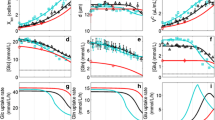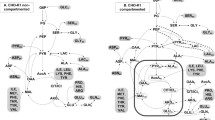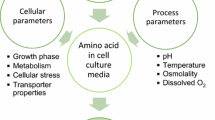Abstract
In bioprocess engineering, the growth of continuous cell lines is mainly studied with respect to the changes in cell concentration, the resulting demand for substrates, and the accumulation of extracellular metabolites. The underlying metabolic process rests upon intracellular metabolite pools and their interaction with enzymes in the form of substrates, products, or allosteric effectors. Here, we quantitatively analyze time courses of 29 intracellular metabolites of adherent Madin–Darby canine kidney cells during cultivation in a serum-containing medium and a serum-free medium. The cells, which originated from the same pre-culture, showed similar overall growth behavior and only slight differences in their demand for the substrates glucose (GLC), glutamine (GLN), and glutamate (GLU). Analysis of intracellular metabolites, which mainly cover the glycolytic pathway, the citric acid cycle, and the nucleotide pools, revealed surprisingly similar dynamics for both cultivation conditions. Instead of a strong influence of the medium, we rather observed a growth phase-specific behavior in glycolysis and in the lower citric acid cycle. Furthermore, analysis of the lower part of glycolysis suggests the well-known regulation of pyruvate kinase by fructose 1,6-bisphosphate. The upper citric acid cycle (citrate, cis-aconitate, and isocitrate) is apparently uncoupled from the lower part (α-ketoglutarate, succinate, fumarate, and malate), which is in line with the characteristics of a truncated cycle. Decreased adenosine triphosphate and guanosine triphosphate pools, as well as a relatively low energy charge soon after inoculation of cells, indicate a high demand for cellular energy and the consumption of nucleotides for biosynthesis. We finally conclude that, with sufficient availability of substrates, the dynamics of GLC and GLN/GLU metabolism is influenced mainly by the cellular growth regime and regulatory function of key enzymes.






Similar content being viewed by others
References
Atkinson DE (1969) Regulation of enzyme function. Annu Rev Microbiol 23:47–68
Atkinson DE, Walton GM (1967) Adenosine triphosphate conservation in metabolic regulation. Rat liver citrate cleavage enzyme. J Biol Chem 242(13):3239–3241
Baggetto LG (1992) Deviant energetic metabolism of glycolytic cancer cells. Biochimie 74(11):959–974
Ballard FJ (1970) Adenine nucleotides and the adenylate kinase equilibrium in livers of foetal and newborn rats. Biochem J 117(2):231–235
Barnabé N, Butler M (2000) The effect of glucose and glutamine on the intracellular nucleotide pool and oxygen uptake rate of a murine hybridoma. Cytotechnology 34(1–2):47–57
Bock A, Sann H, Schulze-Horsel J, Genzel Y, Reichl U, Möhler L (2009) Growth behavior of number distributed adherent MDCK cells for optimization in microcarrier cultures. Biotechnol Prog 25(6):1717–1731
Cruz HJ, Ferreira AS, Freitas CM, Moreira JL, Carrondo MJ (1999) Metabolic responses to different glucose and glutamine levels in baby hamster kidney cell culture. Appl Microbiol Biotechnol 51(5):579–585
Dietmair S, Hodson MP, Quek L-E, Timmins NE, Chrysanthopoulos P, John SS, Gray P, Nielsen LK (2012) Metabolite profiling of CHO cells with different growth characteristics. Biotechnol Bioeng 109:1404–1414
Eigenbrodt E, Glossmann H (1980) Glycolysis—one of the keys to cancer. Trends Pharmacol Sci 1(9):240–245
Erlinger SU, Saier MH (1982) Decrease in protein content and cell volume of cultured dog kidney epithelial cells during growth. Vitro 18(3 Pt 1):196–202
Fitzpatrick L, Jenkins HA, Butler M (1993) Glucose and glutamine metabolism of a murine B-lymphocyte hybridoma grown in batch culture. Appl Biochem Biotechnol 43(2):93–116
Genzel Y, Behrendt I, König S, Sann H, Reichl U (2004) Metabolism of MDCK cells during cell growth and influenza virus production in large-scale microcarrier culture. Vaccine 22(17--18):2202--2208
Genzel Y, Reichl U (2007) Methods in biotechnology: animal cell biotechnology: vaccine production-state of the art and future needs in upstream processing. Humana, Totowa
Genzel Y, Ritter JB, König S, Alt R, Reichl U (2005) Substitution of glutamine by pyruvate to reduce ammonia formation and growth inhibition of mammalian cells. Biotechnol Prog 21(1):58–69
Genzel Y, Fischer M, Reichl U (2006) Serum-free influenza virus production avoiding washing steps and medium exchange in large-scale microcarrier culture. Vaccine 24(16):3261–3272
Genzel Y, Dietzsch C, Rapp E, Schwarzer J, Reichl U (2010) MDCK and Vero cells for influenza virus vaccine production: a one-to-one comparison up to lab-scale bioreactor cultivation. Appl Microbiol Biotechnol 88(2):461–475
Glacken MW, Adema E, Sinskey AJ (1988) Mathematical descriptions of hybridoma culture kinetics: I. Initial metabolic rates. Biotechnol Bioeng 32(4):491–506
Häggström L, Ljunggren J, Ohman L (1996) Metabolic engineering of animal cells. Ann N Y Acad Sci 782:40–52
Hume DA, Radik JL, Ferber E, Weidemann MJ (1978) Aerobic glycolysis and lymphocyte transformation. Biochem J 174(3):703–709
Janke R, Genzel Y, Wahl A, Reichl U (2010) Measurement of key metabolic enzyme activities in mammalian cells using rapid and sensitive microplate-based assays. Biotechnol Bioeng 107(3):566–581
Janke R, Genzel Y, Handel N, Wahl A, Reichl U (2011) Metabolic adaptation of MDCK cells to different growth conditions: effects on catalytic activities of central metabolic enzymes. Biotechnol Bioeng 108(11):2691–2704
Kallel H, Jouini A, Majoul S, Rourou S (2002) Evaluation of various serum and animal protein free media for the production of a veterinary rabies vaccine in BHK-21 cells. J Biotechnol 95(3):195–204
Lee YY, Yap MGS, Hu W-S, Wong KTK (2003) Low-glutamine fed-batch cultures of 293-HEK serum-free suspension cells for adenovirus production. Biotechnol Prog 19(2):501–509
Levine AJ, Puzio-Kuter AM (2010) The control of the metabolic switch in cancers by oncogenes and tumor suppressor genes. Science 330(6009):1340–1344
Levine KB, Cloherty EK, Hamill S, Carruthers A (2002) Molecular determinants of sugar transport regulation by ATP. Biochemistry 41(42):12629–12638
Loret MO, Pedersen L, François J (2007) Revised procedures for yeast metabolites extraction: application to a glucose pulse to carbon-limited yeast cultures, which reveals a transient activation of the purine salvage pathway. Yeast 24(1):47–60
Macheda ML, Rogers S, Best JD (2005) Molecular and cellular regulation of glucose transporter (GLUT) proteins in cancer. J Cell Physiol 202(3):654–662
Mckeehan W (1982) Glycolysis, glutaminolysis and cell-proliferation. Cell Biology International Reports 6(7):635–650
Moreno-Sánchez R, Rodríguez-Enríquez S, Marín-Hernández A, Saavedra E (2007) Energy metabolism in tumor cells. FEBS J 274(6):1393–1418
Neermann J, Wagner R (1996) Comparative analysis of glucose and glutamine metabolism in transformed mammalian cell lines, insect and primary liver cells. J Cell Physiol 166(1):152–169
Nelson CA, Wang JQ, Leav I, Crane PD (1996) The interaction among glucose transport, hexokinase, and glucose-6-phosphatase with respect to 3H-2-deoxyglucose retention in murine tumor models. Nucl Med Biol 23(4):533–541
Nielsen LK, Reid S, Greenfield PF (1997) Cell cycle model to describe animal cell size variation and lag between cell number and biomass dynamics. Biotechnol Bioeng 56(4):372–379
Niklas J, Schräder E, Sandig V, Noll T, Heinzle E (2011) Quantitative characterization of metabolism and metabolic shifts during growth of the new human cell line AGE1.HN using time resolved metabolic flux analysis. Bioprocess Biosyst Eng 34(5):533–545
Purich DL, Fromm HJ (1972) Studies on factors influencing enzyme responses to adenylate energy charge. Journal of Biological Chemistry 247(1):249
Rehberg M, Ritter JB, Genzel Y, Flockerzi D, Reichl U (2013) The relation between growth phases, cell volume changes and metabolism of adherent cells during cultivation. J Biotechnol 164(4):489–499
Reijenga KA, Snoep JL, Diderich JA, van Verseveld HW, Westerhoff HV, Teusink B (2001) Control of glycolytic dynamics by hexose transport in Saccharomyces cerevisiae. Biophys J 80(2):626–634
Reitzer LJ, Wice BM, Kennell D (1979) Evidence that glutamine, not sugar, is the major energy source for cultured HeLa cells. J Biol Chem 254(8):2669–2676
Renner ED, Plagemann PG, Bernlohr RW (1972) Permeation of glucose by simple and facilitated diffusion by Novikoff rat hepatoma cells in suspension culture and its relationship to glucose metabolism. J Biol Chem 247(18):5765–5776
Ritter J (2010) Charakterisierung tierischer Zellkulturen anhand einer Quantifizierung intrazellulärer Metaboliten aus dem Zentralstoffwechsel. Dissertation, Otto-von-Guericke University Magdeburg
Ritter JB, Genzel Y, Reichl U (2006) High-performance anion-exchange chromatography using on-line electrolytic eluent generation for the determination of more than 25 intermediates from energy metabolism of mammalian cells in culture. J Chromatogr B Analyt Technol Biomed Life Sci 843(2):216–226
Ritter JB, Genzel Y, Reichl U (2008) Simultaneous extraction of several metabolites of energy metabolism and related substances in mammalian cells: optimization using experimental design. Anal Biochem 373(2):349–369
Ritter JB, Wahl AS, Freund S, Genzel Y, Reichl U (2010) Metabolic effects of influenza virus infection in cultured animal cells: intra- and extracellular metabolite profiling. BMC Syst Biol 4:61
Rodríguez-Enríquez S, Marín-Hernández A, Gallardo-Pérez JC, Moreno-Sánchez R (2009) Kinetics of transport and phosphorylation of glucose in cancer cells. J Cell Physiol 221(3):552–559
Ryll T, Valley U, Wagner R (1994) Biochemistry of growth inhibition by ammonium ions in mammalian cells. Biotechnol Bioeng 44(2):184–193
Schaub J, Reuss M (2008) In vivo dynamics of glycolysis in Escherichia coli shows need for growth-rate dependent metabolome analysis. Biotechnol Prog 24(6):1402–1407
Schmid G, Blanch HW (1992) Extra- and intracellular metabolite concentrations for murine hybridoma cells. Appl Microbiol Biotechnol 36(5):621–625
Sellick CA, Croxford AS, Maqsood AR, Stephens G, Westerhoff HV, Goodacre R, Dickson AJ (2011) Metabolite profiling of recombinant CHO cells: designing tailored feeding regimes that enhance recombinant antibody production. Biotechnol Bioeng 108(12):3025–3031
Sidorenko Y, Wahl A, Dauner M, Genzel Y, Reichl U (2008) Comparison of metabolic flux distributions for MDCK cell growth in glutamine- and pyruvate-containing media. Biotechnol Prog 24(2):311–320
Suarez RK, Moyes CD (2012) Metabolism in the age of ‘omes’. J Exp Biol 215(Pt 14):2351–2357
Sussman I, Erecińska M, Wilson DF (1980) Regulation of cellular energy metabolism: the Crabtree effect. Biochim Biophys Acta 591(2):209–223
Takata K, Iizuka A, Suzuki T, Matsuzaki T, Sugawara M, Shin B, Nomingerel T, Shinoda Y (1999) Sugar transporters in polarized epithelial cells. Acta Histochem Cytoc 32(1):53–58
Thorens B (1993) Facilitated glucose transporters in epithelial cells. Annu Rev Physiol 55:591–608
Traut TW (1994) Physiological concentrations of purines and pyrimidines. Mol Cell Biochem 140(1):1–22
Valley U, Nimtz M, Conradt HS, Wagner R (1999) Incorporation of ammonium into intracellular UDP-activated N-acetylhexosamines and into carbohydrate structures in glycoproteins. Biotechnol Bioeng 64(4):401–417
Verma M, Zakhartsev M, Reuss M, Westerhoff HV (2013) ‘Domino’ systems biology and the ‘A’ of ATP. Biochim Biophys Acta 1827(1):19–29
Wahl A, Sidorenko Y, Dauner M, Genzel Y, Reichl U (2008) Metabolic flux model for an anchorage-dependent MDCK cell line: characteristic growth phases and minimum substrate consumption flux distribution. Biotechnol Bioeng 101(1):135–152
Warburg O, Wind F, Negelein E (1927) The metabolism of tumors in the body. J Gen Physiol 8(6):519–530
Wu R, Racker E (1959) Regulatory mechanisms in carbohydrate metabolism. III. Limiting factors in glycolysis of ascites tumor cells. J Biol Chem 234(5):1029–1035
Yasmeen D, Laird AJ, Hume DA, Weidemann MJ (1977) Activation of 3-O-methyl-glucose transport in rat thymus lymphocytes by concanavalin A. Temperature and calcium ion dependence and sensitivity to puromycin but to cycloheximide. Biochim Biophys Acta 500(1):89–102
Young CD, Lewis AS, Rudolph MC, Ruehle MD, Jackman MR, Yun UJ, Ilkun O, Pereira R, Abel ED, Anderson SM (2011) Modulation of glucose transporter 1 (GLUT1) expression levels alters mouse mammary tumor cell growth in vitro and in vivo. PLoS One 6(8):e23205
Zhang JZ, Behrooz A, Ismail-Beigi F (1999) Regulation of glucose transport by hypoxia. Am J Kidney Dis 34(1):189–202
Author information
Authors and Affiliations
Corresponding author
Electronic supplementary material
Below is the link to the electronic supplementary material.
ESM 1
(PDF 322 kb)
Rights and permissions
About this article
Cite this article
Rehberg, M., Rath, A., Ritter, J.B. et al. Changes in intracellular metabolite pools during growth of adherent MDCK cells in two different media. Appl Microbiol Biotechnol 98, 385–397 (2014). https://doi.org/10.1007/s00253-013-5329-4
Received:
Revised:
Accepted:
Published:
Issue Date:
DOI: https://doi.org/10.1007/s00253-013-5329-4




